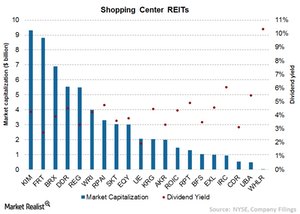Shopping Center REITs Are Sensitive to Economic Cycles
Shopping center REITs mainly own and operate shopping centers that are smaller than retail malls. They’re mainly driven by higher consumer spending.
Nov. 20 2020, Updated 11:05 a.m. ET

Shopping center REITs
Shopping center REITs mainly own and operate shopping centers that are smaller than retail malls. A typical shopping center covers an area of around 100,000–150,000 square feet. Shopping centers mainly consist of convenience centers, neighborhood centers, community centers, power centers, and lifestyle centers.
Like retail malls, shopping center REITs are also mainly driven by higher consumer spending. Other major drivers of shopping center REITs include favorable demographics, location, and the type of shopping center.
Major companies
There are 20 REITs in the shopping center segment with a combined market capitalization of $62.2 billion. They account for 7% of the total REITs market capitalization. Kimco Realty (KIM) is the largest REIT in the segment with a market capitalization of $9.3 billion. It’s followed by Federal Realty Investment (FRT) with $8.8 billion and Brixmor Property Group (BRX) with $6.9 billion. The average dividend yield of the shopping center REITs was 4.35% as of June 2015. Wheeler Real Estate Investment Trust (WHLR) provided the highest dividend yield in the sector at 10.34%.
Investors looking for diversification in the REIT sector can get exposure to REIT ETFs like the Vanguard REIT ETF (VNQ), the iShares U.S. Real Estate ETF (IYR), and the iShares Cohen & Steers REIT ETF (ICF).
